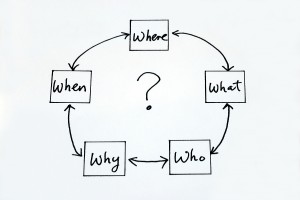I keep six honest serving-men
(They taught me all I knew);
Their names are What and Why and When
And How and Where and Who.
(They taught me all I knew);
Their names are What and Why and When
And How and Where and Who.
~ Rudyard Kipling
Asking these questions has become known as "the Kipling method" after the little ditty in his Just So Stories.
When you are wrestling with the often abstract concepts in business and economics, these are excellent questions to bring you down to earth.
In fact, they've been used for centuries to get at the essence of something. In the 19th Century, Prof. William Cleaver Wilkinson popularized the "Three Ws" – What? Why? What of it? – as a method of Bible study:
"What? Why? What of it?" is a plan of study of alliterative methods for the teacher emphasized by Professor W.C. Wilkinson not as original with himself but as of venerable authority. "It is, in fact," he says, "an almost immemorial orator's analysis. First the facts, next the proof of the facts, then the consequences of the facts. This analysis has often been expanded into one known as "The Five Ws:" "When? Where? Who? What? Why?" Hereby attention is called, in the study of any lesson: to the date of its incidents; to their place or locality; to the person speaking or spoken to, or to the persons introduced, in the narrative; to the incidents or statements of the text; and, finally, to the applications and uses of the lesson teachings.How can you use this idea? David Straker offers some good advice. He suggests expanding the basic questions:
One approach with this is to use the questions in a particular order to help guide you through a sequence of thought towards a complete answer, such as:Try it the next time you're wrestling with a difficult concept.
- What is the problem?
- Where is it happening?
- When is it happening?
- Why is it happening?
- How can you overcome this problem?
- Who do you need to get involved?
- When will you know you have solved the problem?

No comments:
Post a Comment